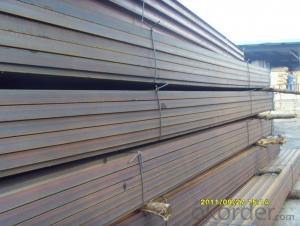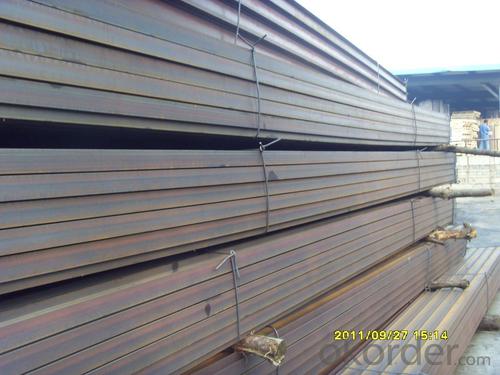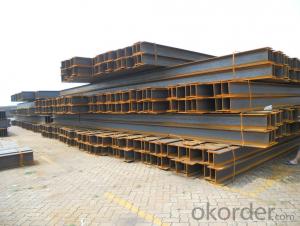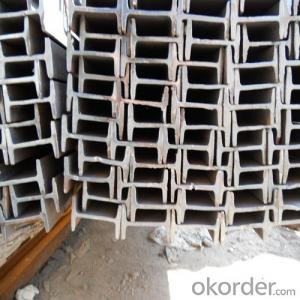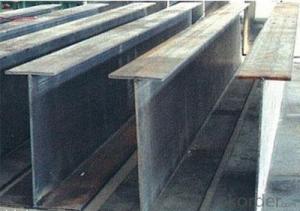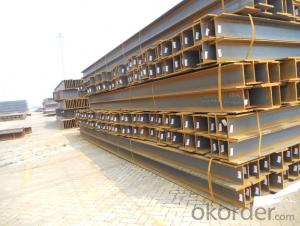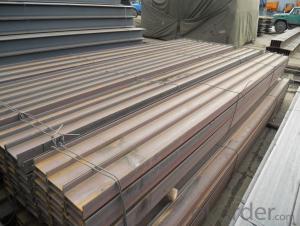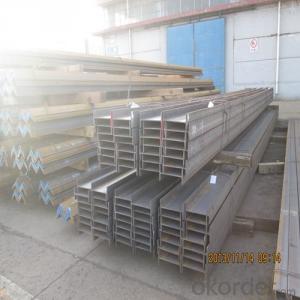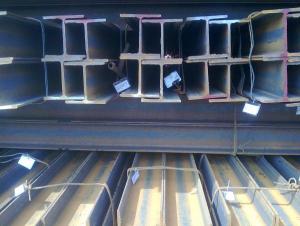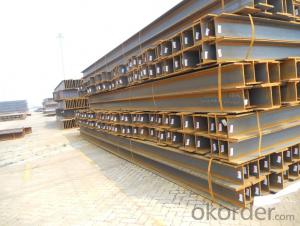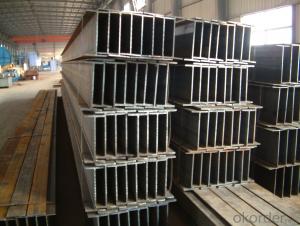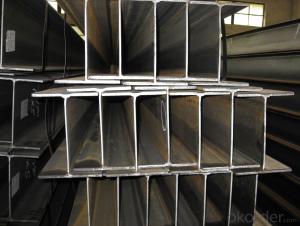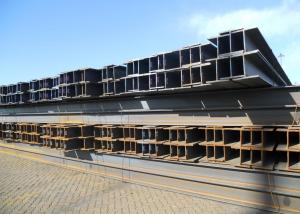High Quality Hot Rolled Q235, SS400 or Equivalent Steel H-Beam for Construction
- Loading Port:
- China main port
- Payment Terms:
- TT OR LC
- Min Order Qty:
- 25000 m.t.
- Supply Capability:
- 200000 m.t./month
OKorder Service Pledge
OKorder Financial Service
You Might Also Like
Specification
Product Description:
Specifications of High Quality Hot Rolled Q235, SS400 or Equivalent Steel H-Beam for Construction
1. Standard: GB700-88, Q235B2.
2. Grade: Q235, SS400 or Equivalent
3. Length: 6m,10m, 12m as following table
4. Invoicing on theoretical weight or actual weight as customer request
5.Payment: TT or L/C
6. Sizes:
SIZE(mm) | DIMENSION(kg/m) |
100*100 | 16.9 |
125*125 | 23.6 |
150*75 | 14 |
150*150 | 31.1 |
148*100 | 20.7 |
198*99 | 17.8 |
200*100 | 20.9 |
248*124 | 25.1 |
250*125 | 29 |
Usage & Applications of High Quality Hot Rolled Q235, SS400 or Equivalent Steel H-Beam for Construction
Commercial building structure ;Pre-engineered buildings; Machinery support structure; Prefabricated structure; Medium scale bridges; Ship-building structure. etc.
Packaging & Delivery of High Quality Hot Rolled Q235, SS400 or Equivalent Steel H-Beam for Construction
1. Packing: it is nude packed in bundles by steel wire rod
2. Bundle weight: not more than 3.5MT for bulk vessel; less than 3 MT for container load
3. Marks:
Color marking: There will be color marking on both end of the bundle for the cargo delivered by bulk vessel. That makes it easily to distinguish at the destination port.
Tag mark: there will be tag mark tied up on the bundles. The information usually including supplier logo and name, product name, made in China, shipping marks and other information request by the customer.
If loading by container the marking is not needed, but we will prepare it as customer request.
4. Transportation: the goods are delivered by truck from mill to loading port, the maximum quantity can be loaded is around 40MTs by each truck. If the order quantity cannot reach the full truck loaded, the transportation cost per ton will be little higher than full load.
5. Delivered by container or bulk vessel
Production flow of High Quality Hot Rolled Q235, SS400 or Equivalent Steel H-Beam for Construction
Material prepare (billet) —heat up—rough rolling—precision rolling—cooling—packing—storage and transportation
Images
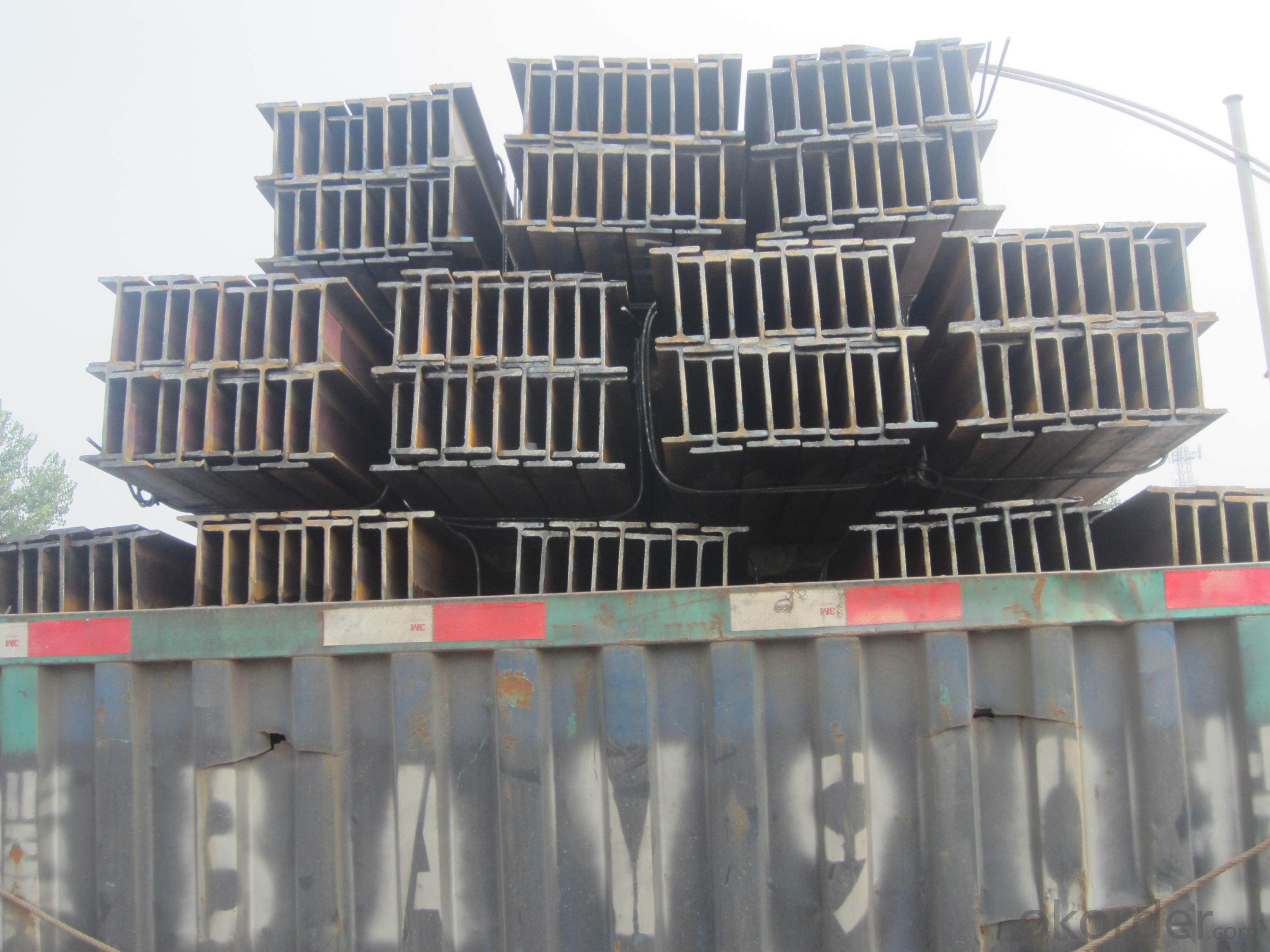
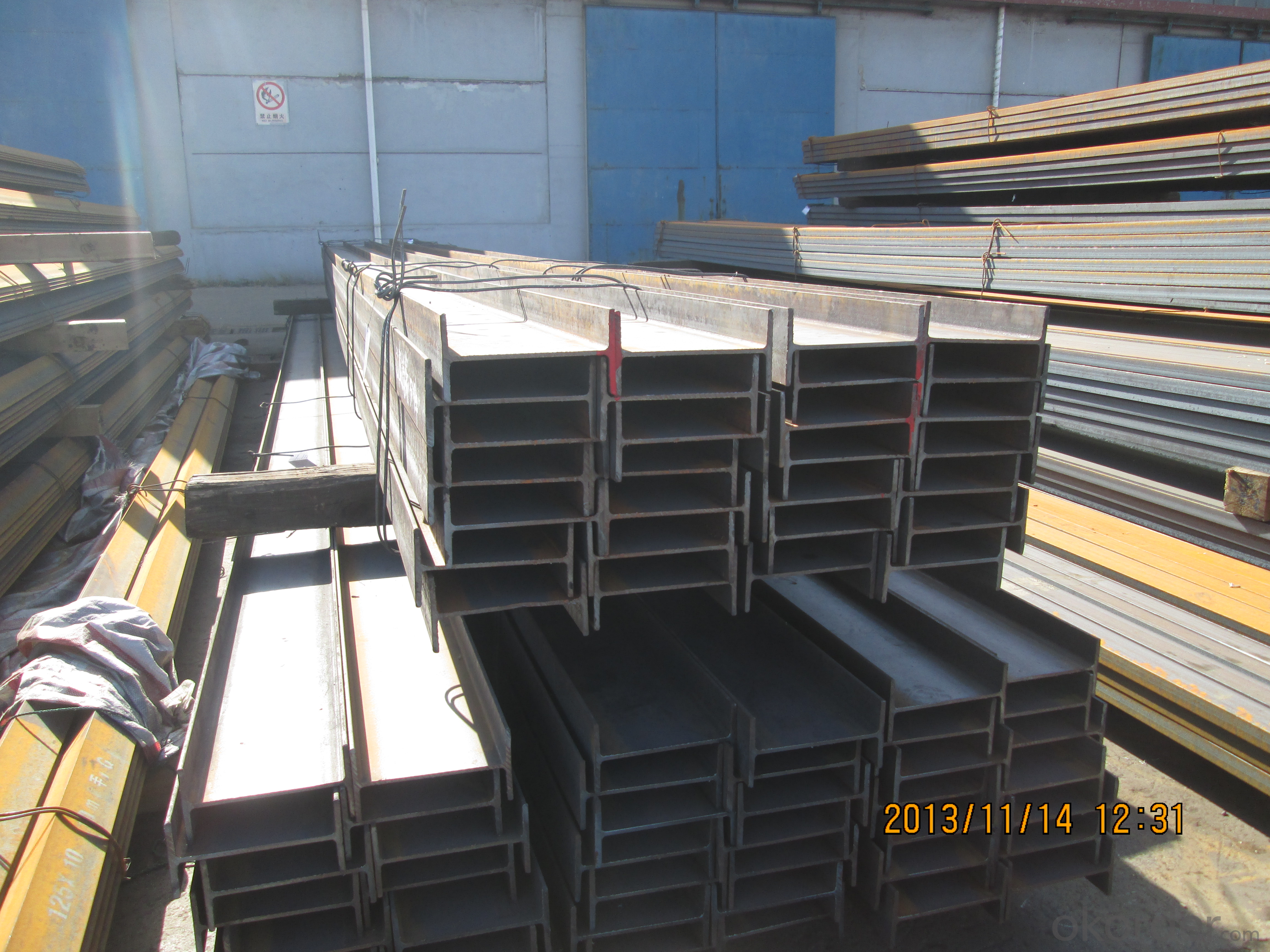
- Q: Are steel H-beams resistant to pests and insects?
- Steel H-beams possess exceptional resistance against pests and insects. In contrast to wooden beams, which are susceptible to termites, ants, and various other pests, steel beams do not offer nourishment or shelter to these creatures. Furthermore, steel beams remain unaffected by rot or decay, thereby eradicating the possibility of harm caused by wood-boring insects. Consequently, steel H-beams emerge as a superb option for construction endeavors undertaken in regions susceptible to infestations by pests.
- Q: Can steel H-beams be used for educational buildings?
- Yes, steel H-beams can be used for educational buildings. Steel H-beams are commonly used in construction due to their structural integrity and strength. They provide excellent support and can withstand heavy loads, making them suitable for educational buildings that may have multiple floors or large open spaces. Additionally, steel H-beams are fire-resistant, which is an important safety feature for any building, especially educational facilities. Furthermore, steel is a durable material that requires little maintenance and can withstand harsh weather conditions, ensuring the longevity of the educational building. Overall, steel H-beams are a reliable and versatile choice for constructing educational buildings.
- Q: What is the difference between wide flange and I-beam steel H-beams?
- Wide flange and I-beam steel H-beams differ primarily in their shape and dimensions. Wide flange beams, also known as W beams, have a wider flange and are more commonly used in structural applications. They have a wider profile, resembling the letter "H" when viewed from the side. On the other hand, I-beam steel H-beams have a narrower flange and are typically used in applications where weight-bearing capacity is crucial, such as in bridges and high-rise buildings. The shape of I-beam steel H-beams resembles the letter "I" when viewed from the side. Overall, the main difference lies in their dimensions and specific applications.
- Q: Are steel H-beams suitable for residential extensions?
- Indeed, residential extensions can be aptly accommodated by steel H-beams. These beams are widely employed in construction owing to their robust structural integrity and ability to bear substantial loads. They offer exceptional reinforcement for supplementary floors, extensions to roofs, and other alterations within residential edifices. Steel H-beams present numerous benefits, encompassing durability, longevity, and resistance against fire, moisture, and pests. Furthermore, they facilitate versatile architectural designs and can be seamlessly integrated into diverse construction systems. All in all, steel H-beams stand as a dependable and efficient selection for residential extensions, guaranteeing the stability and security of the structure.
- Q: What are the different types of steel H-beam connections used in residential buildings?
- Residential buildings commonly utilize various types of steel H-beam connections to ensure stability and strength for the overall structure. Here are some examples: 1. Welded Connection: The most frequently used connection method in residential buildings involves directly welding the H-beam to the supporting structure, such as columns or beams. This technique employs high-strength welding techniques to provide excellent strength and rigidity, making it suitable for applications with heavy loads or high lateral forces. 2. Bolted Connection: Another option is to use high-strength bolts to connect the H-beam to the supporting structure. This method offers easy installation and allows for convenient disassembly or modification when necessary. Bolted connections are commonly employed in situations that require adjustability or removability of the H-beam, such as mezzanine floors or temporary structures. 3. Shear Plate Connection: This type of connection involves placing steel plates on both sides of the H-beam, which are then bolted together. By distributing the load from the beam to the supporting structure, shear plate connections provide excellent strength and stability. They are commonly utilized when the H-beam needs to withstand heavy loads or moments. 4. Clip Angle Connection: Clip angle connections utilize steel angles that are welded to both the H-beam and the supporting structure. These angles provide additional support and rigidity to the connection. Clip angle connections are often employed in situations where the H-beam needs to resist lateral loads or uplift forces. 5. Moment Connection: Moment connections are specifically designed to resist rotational forces or moments. These connections combine welding and bolting techniques to ensure a rigid and strong connection between the H-beam and the supporting structure. Moment connections are frequently used to support large cantilevered structures or heavy loads. It is worth noting that the selection of a specific type of steel H-beam connection for a residential building depends on various factors, including load requirements, architectural design, and recommendations from structural engineers.
- Q: How do steel H-beams compare to wooden beams in terms of strength?
- Steel H-beams are significantly stronger than wooden beams when comparing their strength. Steel is known for its exceptional strength and durability, making it a popular choice for structural components such as H-beams. These beams are specifically designed to provide maximum strength and support, making them ideal for large-scale construction projects and heavy-load applications. Wooden beams, on the other hand, have limitations in terms of strength compared to steel. While wood can be a suitable option for smaller, less demanding structures, it may not have the same load-bearing capacity as steel. Wood is prone to warping, splitting, and decay over time, which can compromise its overall strength and structural integrity. Steel H-beams, being made of a much stronger material, can withstand higher loads and offer better resistance to bending, twisting, and shearing forces. This enhanced strength allows them to support larger spans and heavier loads, making them a preferred choice in high-rise buildings, bridges, and industrial structures. Additionally, steel H-beams have a higher strength-to-weight ratio compared to wooden beams. This means that they can provide greater strength while using less material, resulting in lighter and more cost-effective structures. Moreover, steel is not susceptible to termite damage, rot, or other environmental factors that can degrade wooden beams over time, ensuring long-term durability. In conclusion, steel H-beams outperform wooden beams in terms of strength due to their inherent characteristics. They offer superior load-bearing capacity, increased resistance to various forces, and better durability, making them the preferred choice for heavy-duty construction projects.
- Q: Can steel H-beams be used in the construction of railway infrastructure?
- Yes, steel H-beams can be used in the construction of railway infrastructure. H-beams, also known as I-beams or universal beams, are commonly used in construction due to their structural strength and versatility. They are designed to withstand heavy loads and provide stability, making them suitable for various applications in railway infrastructure. Steel H-beams can be utilized in the construction of railway bridges, railway tracks, and other supporting structures. They are often used as girders to support the weight of railway tracks, ensuring stability and durability. H-beams can also be used in the construction of railway stations, platforms, and other railway buildings. The advantages of using steel H-beams in railway infrastructure construction include their high strength-to-weight ratio, which allows for efficient use of materials while ensuring structural integrity. They are also corrosion-resistant, which is crucial for railway infrastructure exposed to harsh weather conditions. Moreover, steel H-beams can be fabricated to specific sizes and shapes to meet the requirements of a particular railway project. Overall, steel H-beams are an ideal choice for constructing railway infrastructure due to their strength, durability, and versatility. They provide the necessary support and stability required for railway tracks, bridges, and other structures, ensuring the safe and efficient operation of the railway system.
- Q: How do steel H-beams contribute to the overall natural light penetration in a building?
- Steel H-beams do not directly contribute to the overall natural light penetration in a building. The primary purpose of H-beams is to provide structural support and stability to the building's framework. However, the design and placement of H-beams within a building's structure can indirectly impact the natural light penetration. Architects and engineers often strategically design buildings with large windows, skylights, or other openings to allow natural light to enter the space. When incorporating steel H-beams into the building's structure, they are typically placed in areas where they won't hinder the placement of windows or other light openings. By correctly positioning the H-beams, architects can ensure that they don't obstruct the path of natural light from entering the building. This allows for ample light to penetrate through the windows and other openings, illuminating the interior spaces. Moreover, steel H-beams are known for their strength and ability to support heavy loads, which allows architects to design larger and wider windows without compromising the structural integrity of the building. The use of H-beams in the construction process allows for the creation of open and airy spaces that maximize the amount of natural light that enters the building. In summary, while steel H-beams themselves do not directly contribute to natural light penetration, their proper placement and structural support enable architects to design buildings with more extensive windows and openings, facilitating the overall natural light penetration throughout the space.
- Q: Are steel H-beams suitable for structures with high humidity?
- Steel H-beams are generally suitable for structures with high humidity. This is because steel is known for its durability and resistance to moisture. However, it is important to consider the specific conditions and level of humidity in the structure. If the humidity levels are extremely high or if there is constant exposure to moisture, additional measures may need to be taken to prevent corrosion and ensure the longevity of the H-beams. These measures can include applying protective coatings or using stainless steel beams, which have a higher resistance to corrosion.
- Q: Can steel H-beams be used in airport construction?
- Yes, steel H-beams can be used in airport construction. They are commonly used to provide structural support in the construction of airport terminals, hangars, and other airport facilities due to their strength, durability, and versatility.
Send your message to us
High Quality Hot Rolled Q235, SS400 or Equivalent Steel H-Beam for Construction
- Loading Port:
- China main port
- Payment Terms:
- TT OR LC
- Min Order Qty:
- 25000 m.t.
- Supply Capability:
- 200000 m.t./month
OKorder Service Pledge
OKorder Financial Service
Similar products
Hot products
Hot Searches
Related keywords
